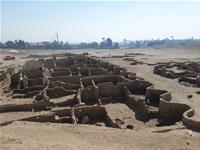Zahi Hawass Center of Egyptology Announces the Discovery of the “Lost Golden City” in Luxor
Posted on

The BA Zahi Hawass Center of Egyptology, in collaboration with the Supreme Council of Antiquities, announced the discovery of a lost ancient city that was buried under the sands for 3000 years, and dubbed “The Rise of Aten.” This city dates back to the reign of Amenhotep III, and continued to be used by Tutankhamun.
Dr. Zahi Hawass said that the excavation process started by searching for the mortuary temple of Tutankhamun because the temples of both Horemheb and Ay were already found in this area. He stated that the expedition discovered the largest city ever found in Egypt. Founded by one of the greatest rulers, King Amenhotep III, the ninth king of the 18th dynasty, who ruled Egypt from 1391 till 1353 B.C, the city was governed by a state of co-regency between the great king and his son, Amenhotep IV/Akhenaton, during the last eight years of his father’s reign.
He added that the city was the largest administrative and industrial settlement in the era of the Egyptian empire on the western bank of Luxor. The walls of some of its houses – which are lined by streets – are up to 3 meters high.
The excavation area lies between the temple of Rameses III at Medinet Habu and that of Amenhotep III at Memnon. The first goal of the mission was to date this city using hieroglyphic inscriptions found on clay caps of wine vessels. Historical references reveal that the city consisted of three royal palaces of king Amenhotep III, together with the empire’s administrative and industrial center.
In the southern part of the city, the mission unearthed a bakery, as well as cooking and food preparation quarters, complete with ovens and storage pottery, which served a large number of workers and employees. The second area, which is still partly uncovered, is the administrative and residential district, with larger and well-arranged units.
The third area represents a workshop that includes mud bricks used to build temples and annexes. The mission also found many tools used in industrial activities like spinning and weaving, in addition to the discovery of stacks of glass and metal.
Moreover, two unusual burials of a cow or bull were uncovered inside one of the rooms, together with an outstanding burial of a person found with arms stretched to his side. A group of rock-cut tombs of different sizes were also discovered inside the city.
It is worth noting that only a third of this area has been unearthed so far. More excavations are underway to discover more untouched tombs filled with treasures.